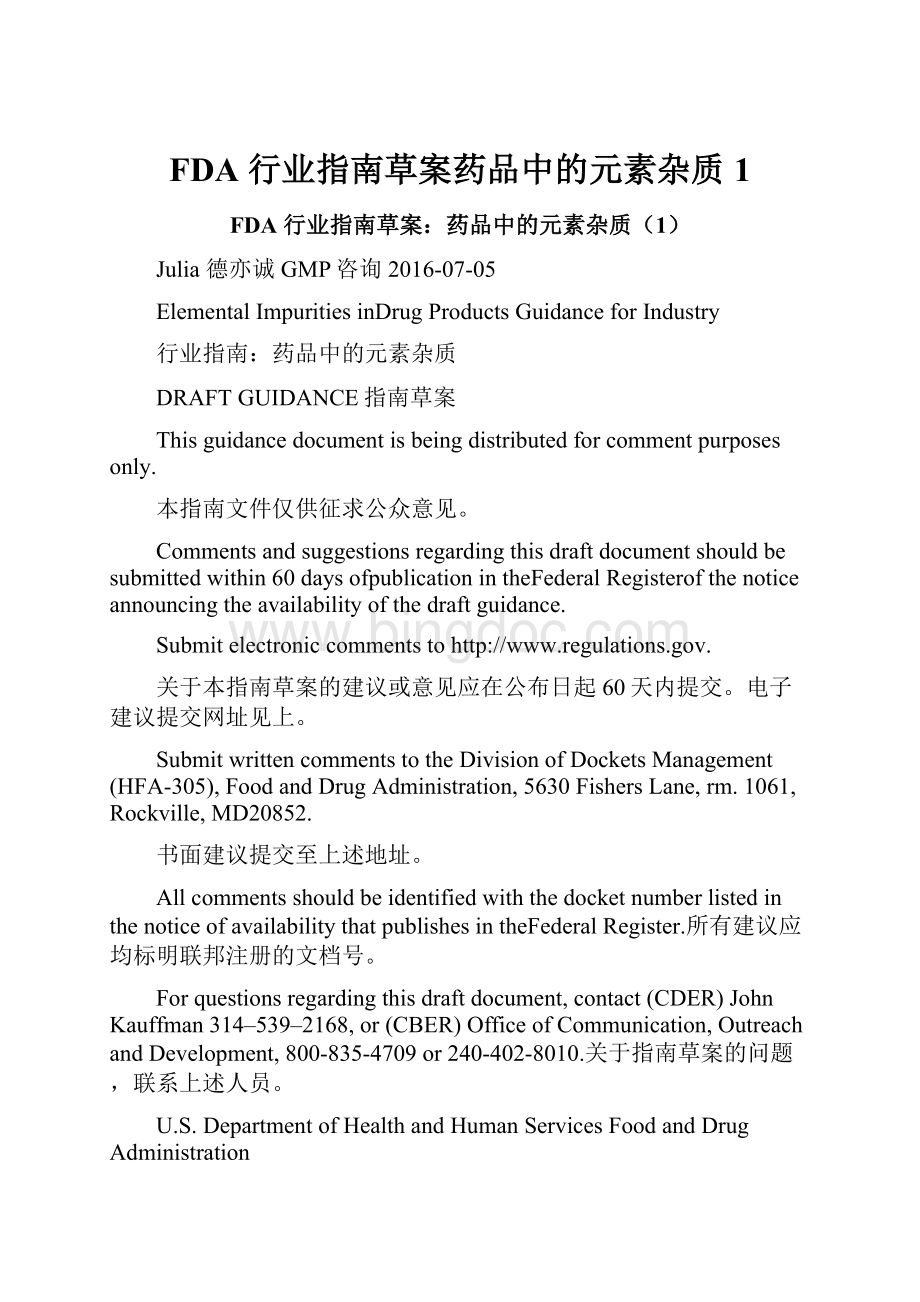FDA 行业指南草案药品中的元素杂质1.docx
《FDA 行业指南草案药品中的元素杂质1.docx》由会员分享,可在线阅读,更多相关《FDA 行业指南草案药品中的元素杂质1.docx(11页珍藏版)》请在冰点文库上搜索。

FDA行业指南草案药品中的元素杂质1
FDA行业指南草案:
药品中的元素杂质
(1)
Julia 德亦诚GMP咨询 2016-07-05
ElementalImpuritiesinDrugProducts GuidanceforIndustry
行业指南:
药品中的元素杂质
DRAFTGUIDANCE指南草案
Thisguidancedocumentisbeingdistributedforcommentpurposesonly.
本指南文件仅供征求公众意见。
Commentsandsuggestionsregardingthisdraftdocumentshouldbesubmittedwithin60daysofpublicationintheFederalRegisterofthenoticeannouncingtheavailabilityofthedraftguidance.
Submitelectroniccommentsto http:
//www.regulations.gov.
关于本指南草案的建议或意见应在公布日起60天内提交。
电子建议提交网址见上。
SubmitwrittencommentstotheDivisionofDocketsManagement(HFA-305),FoodandDrugAdministration,5630FishersLane,rm.1061,Rockville,MD20852.
书面建议提交至上述地址。
Allcommentsshouldbeidentifiedwiththedocketnumberlistedinthenoticeof availabilitythatpublishesintheFederalRegister.所有建议应均标明联邦注册的文档号。
Forquestionsregardingthisdraftdocument,contact(CDER)JohnKauffman314–539–2168,or(CBER)OfficeofCommunication,OutreachandDevelopment,800-835-4709or240-402-8010.关于指南草案的问题,联系上述人员。
U.S.DepartmentofHealthandHumanServices FoodandDrugAdministration
CenterforDrugEvaluationandResearch(CDER)
CenterforBiologicsEvaluationandResearch(CBER)
June2016
PharmaceuticalQuality/CMC
ElementalImpuritiesinDrugProducts GuidanceforIndustry
行业指南:
药品中的元素杂质
U.S.DepartmentofHealthandHumanServices
FoodandDrugAdministration
CenterforDrugEvaluationandResearch(CDER)
CenterforBiologicsEvaluationandResearch(CBER)
June2016
PharmaceuticalQuality/CMC
TABLEOFCONTENTS目录
I.
INTRODUCTION
概述
II.
BACKGROUND
背景
A.
ICHQ3D
ICHQ3D
B.
USPGeneralChapters<232>and<233>
USP通论<232>和<233>
III.
RECOMMENDATIONS
建议
A.
NewCompendialNDAorANDADrugProducts
新药典NDA或ANDA药品
B.
NewNon-compendialNDAandANDADrugProducts
新的非药典NDA和ANDA药品
C.
CompendialDrugProductsNotApprovedUnderanNDAorANDA
不是按NDA和ANDA批准的药典药品
D.
Non-compendialDrugProductsNotApprovedUnderanNDAorANDA
不是按NDA和ANDA批准的非药典药品
E.
ChangestoApprovedNDAsandANDAs
对已批准NDA和ANDA的变更
F.
DocumentationRelatedtotheControlofElementalImpurities
与元素杂质有关的文件
G.
QuantitativeAnalyticalProceduresforElementalImpurities
元素杂质定是分析方法
H.
ValidationofAnalyticalProcedures
分析方法验证
I.
EarlyAdoption
提前实施
ElementalImpuritiesinDrugProducts
GuidanceforIndustry[1]
行业指南:
药品中的元素杂质
Thisdraftguidance,whenfinalized,willrepresentthecurrentthinkingoftheFoodandDrugAdministration(FDAorAgency)onthistopic.ItdoesnotestablishanyrightsforanypersonandisnotbindingonFDAorthepublic.Youcanuseanalternativeapproachifitsatisfiestherequirementsoftheapplicablestatutesandregulations.Todiscussanalternativeapproach,contacttheFDAstaffresponsibleforthisguidanceaslistedonthetitlepage.
本指南草案,当定稿时,将代表FDA当前对此主题的思想。
它并不赋予任何人任何权力,也不对FDA或公众构成义务。
只要符合适用的法规要求,你可以使用其它方法替代。
如需对替代方法进行讨论,请联系在标题页上列出的FDA本指南负责人。
I.INTRODUCTION 概述
Thisdraftguidanceprovidesrecommendationsregardingthecontrolofelementalimpuritiesofhumandrugproducts[2]marketedintheUnitedStatesconsistentwithimplementationofInternationalCouncilforHarmonisation(ICH)guidanceforindustryQ3DElementalImpurities[3].ThisdraftguidancewillalsoassistmanufacturersofcompendiadrugproductsinrespondingtotheissuanceoftheUnitedStatesPharmacopeia(USP)requirement[4]forthecontrolofelementalimpurities.Specifically,thisdraftguidancemakesrecommendationsonthefollowing:
本指南草案提供了在美国销售的人用药品中元素杂质控制的建议,它与ICH行业指南Q3D元素杂质的实施保持一致。
此指南草案也将协助药典药品生产商响应USP中元素杂质控制的要求。
本指南草案主要包括建议如下:
●∙∙Howapplicantssubmittingnewdrugapplications(NDAs)orabbreviatednewdrugapplications(ANDAs)fornon-compendialdrugproductsshouldcontrolelementalImpuritiesasdescribedinICHQ3D.ICHQ3Dcontainsrecommendationsonapplyingarisk-basedapproachtocontrolelementalimpuritiesandpermitteddailyexposure(PDE).
●∙∙提交非药典药品的新药申报(NDA)或简略新药申报(ANDA)的申报人应如何按ICHQ3D指南所述要求控制元素杂质。
ICHQ3D包括了实施基于风险的方法控制元素杂质和日允许暴露量(PDE)的建议。
●∙∙HowmanufacturersofcompendialdrugproductsthatarenotmarketedunderanapprovedNDAorANDAcancomplywithUSPGeneralChapters<232>ElementalImpurities—Limitsand<233>ElementalImpurities—ProceduresandtheFederalFood,Drug,andCosmetic(FD&C)Act.
●∙∙不是以NDA和ANDA申报方式批准的药典药品的生产商如何符合USP通论<232>“元素杂质—限度”和<233>“元素杂质—方法”和联邦食品药品化妆品法案(FDCA)。
●∙∙HowholdersofNDAsorANDAsforcompendialdrugproductsshouldreportchangesinchemistry,manufacturing,andcontrolsspecificationstoFDAtocomplywithGeneralChapters<232>and<233>and21CFR314.70.
●∙∙药典药品的NDA和ANDA持有人应如何向FDA报告CMC变更,以符合通论<232>和<233>以及21CFR314.70.
●∙∙Howmanufacturersofnon-compendialdrugproducts[5]thataremarketedwithoutanapprovedNDAOrANDAshouldcontrolelementalimpurities.
●∙∙不是按NDA或ANDA批准销售的非药典药品的生产商应如何控制元素杂质。
Thisguidancedoesnotincludespecificrecommendationsontheevaluationoftoxicitydataforpotentialelementalimpurities,applicationofarisk-basedapproachtocontrolelementalimpuritiesindrugproducts,orPDE.Forthisinformation,pleaserefertoICHQ3D.
本指南并不包括关于潜在元素杂质毒性数据评估、基于风险控制药品中元素杂质的方法的应用,以及PDE。
此类信息请参见ICHQ3D。
Thisguidancedoesnotaddressbiologicalproducts.HoldersofapprovedorpendingbiologicslicenseapplicationsshouldrefertoICHQ3D[6].
本指南并不针对生物药品。
已批准的和待批准的生物许可申报持有人应参考ICHQ3D。
Ingeneral,FDA’sguidancedocumentsdonotestablishlegallyenforceableresponsibilities.Instead,guidancesdescribetheAgency’scurrentthinkingonatopicandshouldbeviewedonlyasrecommendations,unlessspecificregulatoryorstatutoryrequirementsarecited.TheuseofthewordshouldinAgencyguidancesmeansthatsomethingissuggestedorrecommended,butnotrequired.
一般来说,FDA指南文件并不产生法律强制义务。
指南描述的只是当局目前对某个主题的想法,应仅被看作是建议,文件中引用具体法规或法律要求者除外。
当局指南中使用SHOULD一词表示某事是建议或推荐,但并不是强制要求。
II.BACKGROUND背景
A.ICHQ3D
ICHguidanceforindustryQ3DElementalImpuritiescontainsrecommendationsformanufacturersofhumandrugsandbiologicsonapplyingarisk-basedapproachtocontrolelementalimpuritiesandPDE.
ICH行业指南Q3D元素杂质包括了对人药和生物药品生产商实施基于风险的控制元素杂质和PDE的方法的应用建议。
ICHQ3Drecommendsthatmanufacturersconductaproductriskassessmentbyfirstidentifyingknownandpotentialsourcesofelementalimpurities.Manufacturersshouldconsiderallpotentialsourcesofelementalimpurities,suchaselementsintentionallyadded,elementspotentiallypresentinthematerialsusedtopreparethedrugproduct,andelementspotentiallyintroducedfrommanufacturingequipmentorcontainerclosuresystems.ManufacturersshouldthenevaluateeachelementalimpuritylikelytobepresentinthedrugproductbydeterminingtheobservedorpredictedleveloftheimpurityandcomparingitwiththeestablishedPDE.Iftheriskassessmentfailstoshowthatanelementalimpuritylevelisconsistentlylessthanthecontrolthreshold(definedasBeing30percentoftheestablishedPDEinthedrugproduct),additionalcontrolsshouldbeestablishedtoensurethattheelementalimpurityleveldoesnotexceedthePDEinthedrugproduct.Theseadditionalcontrolscouldbeincludedasin-processcontrolsorinthespecificationsofthedrugproductorcomponents.ICHQ3Dalsodiscussesoptionsfordifferentdosageformsandspecialcircumstancesthatmightaffecttheriskassessmentconclusions.
ICHQ3D建议生产商首先通过辨识已知和潜在元素杂质来源进行产品风险评估。
生产商应该考虑所有潜在的金属杂质来源,例如,有意加入的元素、药品制备过程所用物料中潜在存在的元素,以及从生产设备或包装密闭系统中可能引入的元素。
然后生产商应该通过测定所发现的和所预测的杂质水平,并与所建立的PDE比较,评估每个可能出现在药品中的元素杂质。
如果风险评估未发现元素杂质水平一直低于控制阈值(定义为药品中所建立的PDE值的30%),则应建立附加控制来保证药品中元素杂质水平不会超过PDE值。
这些附加控制可以是中控,也可以放在药品或部件质量标准中。
ICHQ3D还讨论了不同剂型的选择,以及可能会影响风险评估结论的特殊情形。
B.USPGeneralChapters<232>and<233>美国药典USP通论<232>和<233>
USPintroducednewlimitsandanalyticalproceduresforelementalimpuritiesinGeneralChapters<232>ElementalImpurities—Limitsand<233>ElementalImpurities—Procedures.Theirprimarygoalsareto
(1)setlimitsforacceptablelevelsofelementalimpuritiesinfinisheddrugproducts,and
(2)updatethemethodologyusedtotestforelementalimpuritiesindrugproductstoincludemodernanalyticalprocedures.
USP在通论<232>“元素杂质—限度”和<233>“元素杂质—方法”引入了新的元素杂质限度和分析方法。
他们最初的目的是
(1)为制剂成品中的元素杂质设定可接受水平限度,
(2)更新用于测试药品中元素杂质的方法学以包含现代化分析方法。
USPworkedcloselywithICHtoalignitsnewGeneralChapterswithICHQ3D.GeneralChapter<232>endorsesarisk-basedapproachtothecontrolofelementalimpuritiessuchasdescribedinICHQ3D.OftheelementsforwhichICHQ3DprovidesaPDE,15arecoveredbyGeneralChapters<232>and<233>.TheICHQ3DPDEvaluesforthose15elementswereadoptedintheGeneralChapters.
USP与ICH紧密合作,创建了新的通论来与ICHQ3D保持一致。
通论<232>采取了基于风险的方法来控制如ICHQ3D中所述的元素杂质。
在ICHQ3D提供了PDE的元素中,通论<232>和<233>里包括了15个。
ICHQ3D中这15个元素的PDE值在通论中被采纳。
GeneralChapter<232>requirescontrolofelementalimpuritiesinfinisheddrugproductsbutdoesnotrequireroutinetestingofthedrugproduct.DependingonthesourceofanelementalimpurityandtheriskthatitslevelinthefinisheddrugproductwillexceedthePDE,alternativeapproachescanbetaken.Forexample,routinetestingcouldbeperformedonthecomponents(activepharmaceuticalingredient(API)andexcipients)insteadofthefinisheddrugproduct.IftheriskthattheamountofanelementalimpuritywillexceeditsPDEinthedrugproductissufficientlylow,noroutinetestingforthatimpurityneedbeperformed.GeneralChapter<232>requiresassuranceofcompliancetothespecifiedlevelswhenelementalimpuritiesareknowntobepresent,havebeenadded,orhavethepotentialforintroduction.
通论<232>要求对制剂产品中的元素杂质进行控制,但并不要求对药品进行常规测试。
根据元素杂质的来源和其在制剂成品中的水平超出PDE所产生的风险,也可以采用替代方法。
例如,可以对组分进行常规测试(原料药API和辅料),而不需要对制剂进行测试。
如果元素杂质数量超过其在药品中PDE的风险足够低,则不需要常规检测该杂质。
如果已知元素杂质会出现、被加进去或者有可能确实会被引入,则通论<232>要求保证符合指定的水平
Uponimplementation,GeneralChapters<232>and<233>willreplaceGeneralChapter<231>HeavyMetals.AplannedprovisionintheU